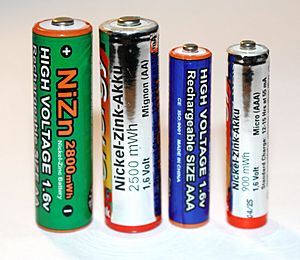Nickel–zinc battery facts for kids
A nickel–zinc battery, often called a NiZn battery, is a special kind of rechargeable battery. This means you can use it, charge it, and use it again, many times! These batteries have a voltage of 1.6 volts, which is a bit higher than common alkaline batteries (1.5V) or NiMH batteries (1.2V).
They get their name because they are made using two main metals: nickel and zinc. People have known about large nickel-zinc battery systems for over 100 years. But it was only after the year 2000 that scientists found ways to make the zinc electrode (a part inside the battery) more stable. This made NiZn batteries much better and able to compete with other popular rechargeable batteries you can buy today. You can find these batteries in common sizes like "AA" and "AAA".
Contents
What Makes Nickel-Zinc Batteries Unique?
Nickel-zinc batteries have some interesting features that make them different from other rechargeable batteries.
Higher Voltage Output
One of the main things that makes NiZn batteries stand out is their higher voltage. Most common rechargeable batteries, like nickel-metal hydride (NiMH) batteries, have a voltage of 1.2 volts. NiZn batteries, however, provide 1.6 volts. This higher voltage can be useful for devices that need a bit more power.
Environmentally Friendly Materials
The materials used in nickel-zinc batteries, like nickel and zinc, are generally considered safer for the environment than some other battery chemicals. This makes them a good choice for people who are looking for more eco-friendly power sources.
How They Store Energy
Inside a NiZn battery, there are two main parts called electrodes. One electrode is made of nickel oxide, and the other is made of zinc. When the battery is used, a chemical reaction happens. Zinc gives up electrons, and nickel oxide accepts them. This flow of electrons creates electricity. When you charge the battery, the process reverses, putting the chemicals back into their original state so they can be used again.
History of Nickel-Zinc Batteries
The idea of nickel-zinc batteries is not new at all! Scientists and inventors have known about these types of batteries for a very long time.
Early Discoveries
The first ideas and experiments with nickel and zinc as battery materials happened over a century ago. Early versions of these batteries were often large and used in industrial settings. However, they had a big problem: the zinc electrode wasn't very stable. It would break down over time, which meant the batteries didn't last very long or couldn't be recharged many times.
Modern Improvements
For many years, this stability problem kept nickel-zinc batteries from becoming popular for everyday use. But around the year 2000, new research and technology helped solve this issue. Scientists found ways to make the zinc electrode much more stable. This breakthrough allowed companies to start making smaller, more reliable NiZn batteries that could be recharged many times, just like other modern rechargeable batteries. This is why you can now find them in sizes like AA and AAA for your electronic gadgets.
Where Are NiZn Batteries Used?
Because of their unique features, nickel-zinc batteries can be a good fit for various devices.
Everyday Electronics
You can use NiZn batteries in many of the same devices where you would use regular AA or AAA batteries. This includes things like:
- Digital cameras
- Remote controls
- Toys
- Flashlights
- Wireless mice and keyboards
Devices Needing Higher Voltage
Some electronic devices perform better or need a specific voltage to work correctly. The 1.6 volts provided by NiZn batteries can be an advantage for these items. For example, some older devices designed for alkaline batteries (1.5V) might work better with NiZn batteries than with 1.2V NiMH batteries.
See also
 In Spanish: Batería de níquel-zinc para niños
In Spanish: Batería de níquel-zinc para niños


